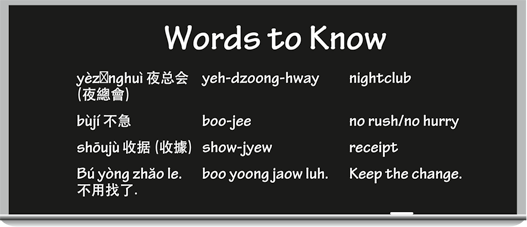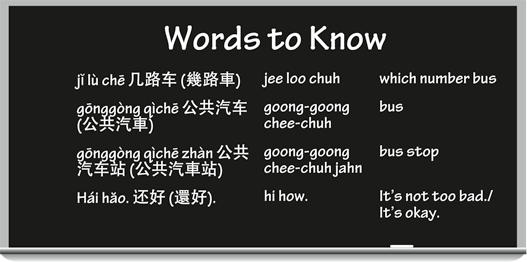Chinese For Dummies (114 page)
Read Chinese For Dummies Online
Authors: Wendy Abraham
Okay. Thanks.

Hopping on the bus
GÅnggòng qìchÄ
å
Œ
±æ±½è½¦
(
å
Œ
±æ±½è»
) (goong-goong chee-chuh) (
buses
) are almost as common as bicycles in China. They also cost much less than taxis. But here's the catch: Bus drivers usually don't speak a word of English, signs are only in Chinese, and the buses are always super crowded. Still, if you're game for a unique travel experience and you don't mind killing time waiting for the bus, put these phrases in your carry-on bag:
 ChÄ pià o duÅshÇo qián?
ChÄ pià o duÅshÇo qián?
车票å¤å°é±
? (
è»ç¥¨å¤å°é¢
?) (chuh pyaow dwaw-shaow chyan?) (
How much is the fare?
)
 DuÅjiÇ lái yÃtà ng?
DuÅjiÇ lái yÃtà ng?
å¤ä¹
æ¥ä¸è¶
? (
å¤ä¹
ä¾ä¸è¶
?) (dwaw-jyo lye ee-tahng?) (
How often does it come?
)
 GÅnggòng qìchÄ zhà n zà i nÇr?
GÅnggòng qìchÄ zhà n zà i nÇr?
å
Œ
±æ±½è½¦ç«å¨åªå¿
? (
å
Œ
±æ±½è»ç«å¨åªå
?) (goong-goong chee-chuh jahn dzye nar?) (
Where's the bus station?
)
 QÇng gà osù wÇ zà i nÇr xià chÄ.
QÇng gà osù wÇ zà i nÇr xià chÄ.
请åè¯æå¨åªå¿ä¸è½¦
.
(
è«å訴æå¨åªå
ä¸è»
.)
(cheeng gaow-soo waw dzye nar shyah chuh.) (
Please let me know where to get off.
)
 YÄ«nggÄi zuò jÇ lù chÄ?
YÄ«nggÄi zuò jÇ lù chÄ?
åºè¯¥åå 路车
? (
æ該å幾路è»
?) (eeng-guy dzwaw jee loo chuh?) (
Which [number] bus should I take?
)
Talkin' the Talk
Charlie is walking along the street, trying to find a bus that can take him to the famous Shilin night market in Taiwan. He sees his old friend Louise, and after saying hello, he asks her for help.
Charlie:
Qù ShÃlÃn yÄ«nggÄi zuò jÇ lù gÅnggòng qìchÄ?
chyew shir-leen eeng-guy dzwaw jee loo goong-goong chee-chuh?
Which bus should I take to go to Shilin?
Louise:
YÄ«nggÄi zuò sÄn lù chÄ. Nèige gÅnggòng qìchÄ zhà n jiù zà i zhèr.
eeng-guy dzwaw sahn loo chuh. nay-guh goong-goong chee-chuh jahn jyo dzye jar.
You should take the number 3 bus. That bus stop is right here.
Charlie:
Tà i hÇo le. DuÅjiÇ lái yÃtà ng?
tye how luh. dwaw-jyo lye ee-tahng?
That's great. How often does it come?
Louise:
MÄi sÄnshà fÄn zhÅng. Hái hÇo.
may sahn-shir fun joong. hi how.
Every 30 minutes. That's not too bad.
Charlie:
Xièxiè nÇ.
shyeh-shyeh nee.
Thank you.

Riding the rails
If you want to get where you need to go really quickly, especially in Hong Kong or New York, the fastest way to get there may take you below the ground â to the
dìtiÄ
å°é
(
å°éµ
) (dee-tyeh) (
subway
). Most
dìtiÄ zhà n
å°éç«
(
å°éµç«
) (dee-tyeh jahn) (
subway stations
) are pretty easy to navigate.
Unlike in Hong Kong, the subway system in mainland China is relatively new, and you find stations in less than a handful of cities. Above-ground
huÇchÄ
ç«è½¦
(
ç«è»
) (hwaw-chuh) (
train
) travel, however, is tried and true â especially because China is such a huge place and distances between cities are so great. Unlike the number of subway stations, you can find plenty of
huÇchÄzhà n
ç«è½¦ç«
(
ç«è»ç«
) (hwaw-chuh-jahn) (
train stations
) in China
.
They
even come equipped with
waiting rooms.
 If you plan to travel a long distance, be sure to book a soft sleeper â or at least ask for a soft seat â because they're the more comfortable accommodations and not as jam-packed as other parts of the train. Trust me. Soft sleepers are worth the extra cost. For more on the types of seats in trains, see
If you plan to travel a long distance, be sure to book a soft sleeper â or at least ask for a soft seat â because they're the more comfortable accommodations and not as jam-packed as other parts of the train. Trust me. Soft sleepers are worth the extra cost. For more on the types of seats in trains, see
Table 16-2
.
 Â Taking the subway around China
 Taking the subway around China
Hong Kong constantly upgrades and extends its subway system, making it quite reliable. Taipei also has an excellent and efficient subway system. In Shanghai, China's major commercial center of Pudong has a subway that connects the east and west sides of the Huangpu River. And in Beijing, the 2008 Olympics prompted extensive subway expansion in preparation for the hordes that descended into its metro system. It now has 15 lines and close to 200 stations.
Table 16-2 Seating Accommodations on Trains
Chinese | Pronunciation | English |
ruÇnwò | rwahn-waw | soft sleeper |
ruÇnzuò | rwan-dzwaw | soft seat |
shà ngpù | shahng-poo | upper berth |
xià pù | shyah-poo | lower berth |
yìngwò | eeng-waw | hard sleeper |
yìngzuò | eeng-dzwaw | hard seat |